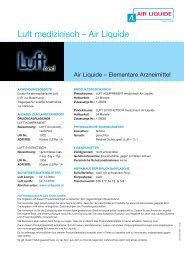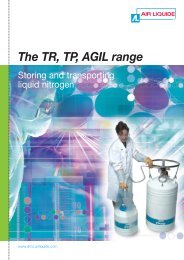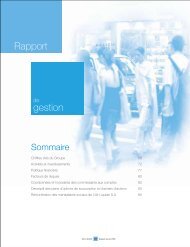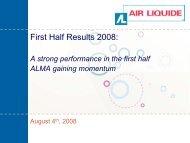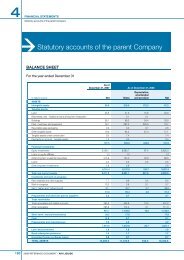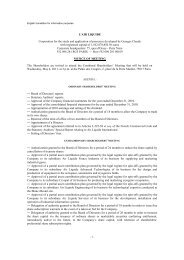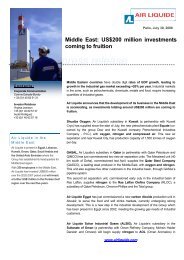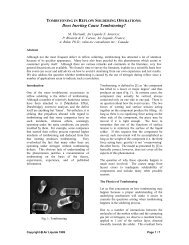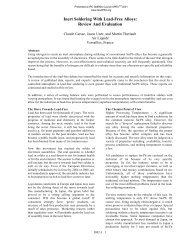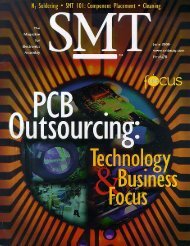A Comprehensive Approach for Delivery of Low- Vapor-Pressure ...
A Comprehensive Approach for Delivery of Low- Vapor-Pressure ...
A Comprehensive Approach for Delivery of Low- Vapor-Pressure ...
Create successful ePaper yourself
Turn your PDF publications into a flip-book with our unique Google optimized e-Paper software.
A <strong>Comprehensive</strong> <strong>Approach</strong> <strong>for</strong> <strong>Delivery</strong> <strong>of</strong> <strong>Low</strong>-<br />
<strong>Vapor</strong>-<strong>Pressure</strong> Process Chemicals<br />
Jean M. Friedt 2 , Hwa-Chi Wang 1 , Rick Udischas 1 , Herve Dulphy 3<br />
Air Liquide<br />
1 5230 S East Ave., Countryside, IL, USA; 2 75 Quai D'Orsay, 75007<br />
Paris; 3 18, rue Aristide Berges, 38000 Le Pont de Claix, France<br />
Abstract:<br />
A number <strong>of</strong> new challenges arise in the distribution technologies <strong>of</strong> chemicals <strong>for</strong><br />
semiconductor manufacturing. They result on the one hand, from the introduction <strong>of</strong><br />
larger wafer sizes and the consequent increase <strong>of</strong> chemicals consumption rate and, on the<br />
other hand, from the introduction <strong>of</strong> the new materials which are required at reduced<br />
device dimensions. We describe here recent developments in vapor phase chemicals<br />
supply technologies, which provide improved quality, reliability and safety, as well as<br />
optimized cost <strong>of</strong> ownership.<br />
Introduction :<br />
For : Semiconductor Fabtech edition 14, Summer 2001<br />
<strong>Vapor</strong> phase processing, eg, CVD, etching or dry cleaning, is ideally suited <strong>for</strong> the<br />
manufacturing <strong>of</strong> sub-micrometric, high-aspect-ratio thin films that are the building<br />
blocks <strong>of</strong> semiconductor (SC) devices. The controllability and quality <strong>of</strong> the vapor phase<br />
processes rely critically on the delivery <strong>of</strong> an “ideal” gas phase to the wafer surface in the<br />
process tool. Whereas this goal has been reached rather easily so far since manufacturing<br />
technologies used mostly high pressure process gases, special challenges are appearing<br />
<strong>for</strong> the emerging technologies : on the one hand, the introduction <strong>of</strong> larger wafer sizes ,<br />
eg 300 mm wafers, involves significantly increased flow rates. When the precursors are<br />
liquefied gases stored at ambient temperature under their own vapor pressure,<br />
withdrawing high flow rate may entrain biphasic gas-liquid flow if the energy <strong>of</strong><br />
vaporization is not properly supplied to the gas-liquid interface [1]. This, in turn, will<br />
induce manufacturing defectivity and loss <strong>of</strong> control <strong>of</strong> the fluid flow parameters.<br />
Separately, as dictated by the ITRS roadmap [2], at design rules below 100 nm, many<br />
new materials <strong>of</strong> specific physico-chemical and mechanical properties need to be<br />
introduced in the SC device structures. It is inconceivable that gas phase precursors under<br />
normal process conditions can be discovered <strong>for</strong> the deposition <strong>of</strong> these new materials.<br />
They will be in either liquid or solid phase at normal conditions, hence requiring the<br />
development <strong>of</strong> advanced distribution technologies <strong>for</strong> reaching the required vapor phase<br />
parameters at the wafer surface [3]. The trend to increasing vapor flow rates and usage <strong>of</strong><br />
chemicals with very low vapor pressure under normal conditions is further motivated by<br />
COO (Cost <strong>of</strong> ownership) and ESH (Environment, safety and health) considerations.<br />
JM Friedt Page 1 01/06/2001
We summarize here some recently developed solutions <strong>for</strong> delivering proper quality<br />
process chemicals <strong>of</strong> various physical and chemical properties to the process chamber.<br />
Specifically, we describe solutions <strong>for</strong><br />
• Localized supply <strong>of</strong> low-vapor-pressure gases such as WF6, Me3SiH, other Methyl<br />
Silanes, ClF3, etc at flow rates <strong>of</strong> up to about 10 liters per minute,<br />
• Centralized supply <strong>of</strong> low-vapor-pressure gases such as Cl2, NH3, Me3SiH, other<br />
Methyl Silanes, etc, at flow rates greater than 10 liters per minute<br />
• Localized supply <strong>of</strong> “very low vapor pressure” liquid chemicals such as TiCl4,<br />
TDMAT, TEOS, PET, DMDMOS, TMCTS, etc at flow rates up to the order <strong>of</strong> 1<br />
liter per minute.<br />
• Centralized supply <strong>of</strong> “very low vapor pressure” liquid chemicals such as TCS,<br />
TEOS, DMDMOS, etc at flow rates greater than 1 liter per minute.<br />
The above indicated flow rates represent typical orders <strong>of</strong> magnitude. Practical selection<br />
will be determined according to the local fab configuration, ie the process recipe and the<br />
number <strong>of</strong> tools to be supplied and by considerations <strong>of</strong> cost, space availability, and<br />
safety. The latter, as well as contamination risk, will be favorably affected by the reduced<br />
frequency <strong>of</strong> chemical container or gas cylinder exchanges.<br />
Localized Supply <strong>of</strong> <strong>Low</strong>-<strong>Vapor</strong>-<strong>Pressure</strong> Gases: all vapor phase (AVP) cylinder<br />
Cabinet<br />
<strong>Low</strong>-vapor-pressure gases are stored in liquefied state and vapor phase is withdrawn<br />
under “ambient” conditions to meet process requirement. External energy addition is<br />
needed to compensate <strong>for</strong> the heat <strong>of</strong> vaporization (typical value <strong>for</strong> currently used<br />
chemical gases is 5 to 20 W/slm to maintain a constant liquid temperature). The required<br />
energy input is normally provided by mere thermal conduction from ambient air.<br />
However, at high flowrates, this natural process becomes insufficient and further means<br />
<strong>of</strong> energy input is needed. Otherwise, the liquid temperature drops and accordingly the<br />
vapor pressure decreases, hence affecting the flow rate. In addition, violent boiling<br />
occurs in an overdrawn cylinder [1] and results in a mist <strong>of</strong> liquid droplets being<br />
introduced into the distribution network and, in some instances, into the process<br />
chambers. Such biphasic fluid emission prevents steady flow control.<br />
A common solution uses a cylinder heating jacket to provide a constant heat flux or a<br />
regulated heat flux in order to maintain the cylinder wall at a constant temperature.<br />
However, under practical conditions, there is a considerable temperature difference<br />
between the liquid inside the cylinder and the outer cylinder wall due to poor thermal<br />
conduction <strong>of</strong> the heterogeneous biphasic chemical-cylinder container system [1]. As a<br />
result, with above procedure, insufficient heating is provided by the heating jacket [4].<br />
Ideally, one would like to match precisely the required evaporation energy, based on the<br />
true temperature <strong>of</strong> the liquid inside <strong>of</strong> the cylinder, or more precisely on the one <strong>of</strong> the<br />
liquid-vapor interface since it is strongly heterogeneous. As it is not practical to install a<br />
temperature sensor inside <strong>of</strong> the cylinder, the liquid temperature is rather derived from<br />
the pressure measurement via the equation <strong>of</strong> state:<br />
JM Friedt Page 2 01/06/2001
Log P = -A/T + B<br />
Where P and T are pressure and temperature, A and B are constants known <strong>for</strong> various<br />
chemicals. Since in practice pressure is routinely monitored at the cylinder exit via a<br />
pressure transducer, the temperature <strong>of</strong> the liquid inside the cylinder can be continuously<br />
calculated from above relationship and used to control the heating device. A patented all<br />
vapor phase (AVP) cabinet [5,6] incorporates such control logic and an efficient heating<br />
device to ensure continuous, single phase, and stable supply <strong>of</strong> low-vapor-pressure gases<br />
(Figure 1).<br />
The integrated heating device is controlled by the same PLC that controls the operation <strong>of</strong><br />
the gas cabinet and is located at the bottom <strong>of</strong> the cylinder to exploit natural convection<br />
within the liquid phase <strong>for</strong> temperature homogeneity. Field data have shown that the<br />
AVP cabinet can increase the usable flow rate by 5X. In addition, the built-in heater<br />
eliminate liquid droplets and the consequent corrosion problems, thereby increasing<br />
reliability and reducing maintenance costs.<br />
Figure 2 represents the delivery simulation <strong>of</strong> WF6 from a single cylinder to a 6chamber,<br />
300 mm tool (AMAT-Endura) with and without AVP technology. The flow<br />
rate reaches 2.4 slm when all chambers are in simultaneous operation. The AVP<br />
technology maintains a constant vapor pressure throughout the run, representating proper<br />
energy input management, whereas conventional cylinder supply clearly suffers from<br />
unacceptable pressure drop. Note that the heating device remains in operation after the<br />
scheduled process in order to bring the liquid temperature back to the set temperature <strong>for</strong><br />
subsequent runs.<br />
Centralized Supply <strong>of</strong> <strong>Low</strong>-<strong>Vapor</strong>-<strong>Pressure</strong> Gases by gas phase distribution : Bulk<br />
evaporation purification systems (BEPS-G)<br />
Centralized supply <strong>of</strong>fers numerous advantageous features in terms <strong>of</strong> cost <strong>of</strong> ownership,<br />
enhanced safety and reduced contamination associated with reduced cylinder change-out,<br />
and improved operational efficiency. On the other hand, the selection <strong>of</strong> such a<br />
centralized supply solution requires a careful risk analysis according to specific local<br />
conditions, eg, regulations, space availability, necessary redundancy, distance from the<br />
bulk source to the process tools, etc. From the design aspect, the pressure needed to<br />
deliver the low-vapor-pressure gases over the entire distribution network to the point <strong>of</strong><br />
use must be carefully evaluated <strong>for</strong> selection <strong>of</strong> the proper heat management solution.<br />
From the operational aspect, one needs to further consider purity assurance and system<br />
reliability indices, ie MTBF and MTTR, as the impact <strong>of</strong> out-<strong>of</strong>-specification chemicals<br />
would affect the whole fab production schedule.<br />
The simplest solution <strong>for</strong> centralized supply <strong>of</strong> low-vapor-pressure gases is based on an<br />
extension <strong>of</strong> the AVP technology to a bulk container, eg, a ton unit equipped with a<br />
heating device <strong>of</strong> appropriate shape and using the same patented control logics [7,8]<br />
JM Friedt Page 3 01/06/2001
(Figure 3). Figure 3 includes the time dependence <strong>of</strong> emitted pressure from a NH3 bulk<br />
container with- and in absence <strong>of</strong> AVP on-demand heating. It is obvious that pressure<br />
cannot be maintained without proper heat input. If the NH3 source container is placed in<br />
a temperature-controlled area, such a simple BEPS-G system can supply the whole fab<br />
with a total flow rate <strong>of</strong> up to several hundreds liters per minute.<br />
Centralized Supply <strong>of</strong> <strong>Low</strong>-<strong>Vapor</strong>-<strong>Pressure</strong> Gases by liquid phase distribution :<br />
Bulk evaporation purification systems (BEPS-L)<br />
An alternative design, BEPS-L, uses pressure-liquefied chemical gas distribution<br />
followed by vaporization at a location close to point <strong>of</strong> use [9]. It is <strong>of</strong> advantage <strong>for</strong> very<br />
low vapor pressure gases or whenever thermal management is difficult under local<br />
circumstances (Figure 4). A significant advantage is the reduced physical dimension<br />
simply because the density <strong>of</strong> liquid is orders <strong>of</strong> magnitude greater than that <strong>of</strong> vapor.<br />
Furthermore, a simple purification scheme can optionally be attached <strong>for</strong> removing heavy<br />
and light impurities by bottom and top purge respectively. It should be emphasized that<br />
the intent is not to place a chemical plant at a fab. But rather, through a simple scheme<br />
and a simple device housed in a 3-cylinder cabinet, (Figure 4), one has the possibility to<br />
eliminate some common contaminants <strong>of</strong>ten associated with handling ,eg, air originated<br />
contaminants (N2/O2/H2O) in the light fraction and metals in the heavy fraction [10].<br />
Table 1 summarizes the typical purification per<strong>for</strong>mance <strong>of</strong> a bulk evaporation<br />
purification system (BEPS-L) <strong>for</strong> Fe, B and H2 impurities, as examples <strong>for</strong> dopant, metal<br />
and volatile impurities, in dichlorosilane. There are a number <strong>of</strong> species and <strong>for</strong>ms in<br />
which the Fe and B contaminants may exist in either the liquid, vapor phase or as<br />
ultrafine particles in either the liquid or vapor phase, or even solid or particulate materials<br />
weakly adhered on the container and components surfaces that are subsequently entrained<br />
in the vapor flow. It is expected however due to the chemical nature <strong>of</strong> Fe and B that the<br />
majority <strong>of</strong> these impurities will be concentrated in the liquid phase relative to the vapor<br />
phase. This effect is expected to be much stronger <strong>for</strong> Fe than B. By contrast however, it<br />
is expected that H2 will be strongly concentrated within the vapor phase. As a result, by<br />
appropriately adjusting the liquid and vapor phase purge rates it is possible to supply an<br />
ESG that is purified <strong>for</strong> both "heavy" impurities (e.g. Fe and B in DCS) and "lights" (e.g.<br />
H2 in DCS) in a relatively small purification package that could supply the needs <strong>of</strong> an<br />
entire fab. Table 1 presents some results <strong>for</strong> the measured per<strong>for</strong>mance <strong>of</strong> a BEPS L <strong>for</strong><br />
these three types <strong>of</strong> impurities in DCS.<br />
Impurity Impurity<br />
concentration<br />
in source<br />
product<br />
BEPS-L<br />
Measured<br />
Per<strong>for</strong>mance<br />
Boron (wtppb) 3.7
The most critical concern when using centralized supply technology arises from the high<br />
risk associated with any possible incident. For instance, an improperly purged<br />
connection could introduce ambient contamination into the whole fab and result in total<br />
production interruption. Hence, continuous quality control (CQC) tools, which have been<br />
standard to qualify high purity nitrogen (HPN) supply <strong>for</strong> years, become necessary <strong>for</strong> a<br />
centralized supply system <strong>for</strong> electronics specialty gases (ESG’s) in order to guard<br />
against any potential irregularities, eg, leakage, corrosion, improper purging, etc.<br />
Moisture and particles detection provides an optimal and universal indication <strong>for</strong> such<br />
irregularities. There<strong>for</strong>e, a mobile analytical cabinet (ALMAC) has been developped <strong>for</strong><br />
monitoring onsite and in real time both moisture and particles in any chemical gas; in<br />
particular it uses diode laser hygrometry which allows <strong>for</strong> a moisture detection limit <strong>of</strong><br />
10 to 100 ppb in any chemical gas [11] . This technique allows to qualify both the<br />
distribution network and the chemicals supply with the actual process chemical prior to<br />
its introduction into the tools. (Figure 5)<br />
Localized and Bulk supply <strong>of</strong> very low vapor pressure chemicals from liquid or solid<br />
phases<br />
As already stated in the introduction, fullfilment <strong>of</strong> the need <strong>for</strong> new materials in<br />
semiconductor devices will involve increasing usage <strong>of</strong> liquid or solid phase precursors<br />
which need to be converted into vapor phase <strong>for</strong> CVD processing.<br />
Despite an extensive history <strong>of</strong> research and development ef<strong>for</strong>t <strong>for</strong> the proper handling<br />
<strong>of</strong> such precursors, it is still considered poorly suited <strong>for</strong> high yield, high quality,<br />
advanced Si device production [3, 12, 13, 14]. Indeed, such liquid phase precursor<br />
handling has been in common usage in Silicon manufacturing technology <strong>for</strong> specific<br />
process steps, eg TEOS, TMP, TMB, etc CVD <strong>for</strong> SiO2 base layers deposition or<br />
Chlorosilanes <strong>for</strong> Si epitaxy; liquid Ti, Ta, etc precursors were used recently <strong>for</strong> interface<br />
liner CVD deposition; also, in III-V and II-VI semiconductor processing, MO CVD using<br />
such liquid phase precursors at ambient conditions is common practice. Finally, much<br />
ef<strong>for</strong>t has been devoted recently to the precursor feed and vaporization techniques <strong>for</strong><br />
high Tc superconductors CVD deposition, which are composed <strong>of</strong> the same elements (Y,<br />
Ba, Cu, etc) as the ones needed in future semiconductor devices and whose properties are<br />
highly sensitive to film quality, ie, composition, stoichiometry, morphology, etc.<br />
Despite this extensive experience and much research <strong>for</strong> improvement, difficulties <strong>of</strong> the<br />
common distribution technologies are well recognized and improved robustness and<br />
process control is requested <strong>for</strong> the generalization <strong>of</strong> these techniques in Si manufacturing<br />
at < 100 nm design rule.<br />
Current emphasis <strong>of</strong> development, as witnessed by the numerous published patents,<br />
focuses on the one hand on the improved distribution technology <strong>of</strong> liquid precursors,<br />
either in pure <strong>for</strong>m or in solution or as molecular adducts, and on the other hand on the<br />
perfect vaporization into gas phase. The technical difficulties arising in particular from<br />
the risks <strong>of</strong> chemical reactivity, thermal or chemical decomposition, particle <strong>for</strong>mation,<br />
JM Friedt Page 5 01/06/2001
viscosity, etc and with the obtention <strong>of</strong> proper vapor phase are well documented in the<br />
literature.<br />
Regarding the industrial structuring, chemicals and materials suppliers usually take direct<br />
responsibility <strong>for</strong> the delivery and distribution equipment logistics <strong>of</strong> the chemicals up<br />
to the process tool entrance; the vaporization equipment itself is normally incorporated<br />
into the process tool and hence the responsibility <strong>of</strong> the tool producer. However,<br />
development and construction <strong>of</strong> the total system is per<strong>for</strong>med in close cooperation<br />
among chemicals suppliers, fluid control equipment producers and process tool<br />
manufacturers.<br />
Liquid feed can be accomplished by pump or by gas pressure-feed technique. Generally<br />
speaking, the pressure-feed technique is preferred because pumps produce pulsating flow<br />
and require frequent services when dealing with chemicals <strong>of</strong> highly reactive nature. The<br />
three most important criteria <strong>for</strong> a chemical delivery system, ie, safety, reliability, and<br />
total availability, have been demonstrated <strong>for</strong> a number <strong>of</strong> state <strong>of</strong> the art commercially<br />
available systems. A fully automated delivery system <strong>for</strong> liquid precursors is represented<br />
in Figure 6. Since the delivery system is rigidly connected to the tool and cannot be<br />
easily modified after installation, it is designed to accept any type <strong>of</strong> chemical ampoule.<br />
A recharge tank with elaborate level sensors is connected in series to the mother tank. As<br />
the recharge tank is fixed in the delivery system and is designed with sufficient capacity,<br />
it can supply liquid precursors <strong>for</strong> several days while the mother tank is being changed.<br />
Cascade pressurization is used <strong>for</strong> the mother tank and the recharge tank. There<strong>for</strong>e, the<br />
recharge tank can continuously deliver liquid precursors including when being refilled.<br />
Extensive purging procedure is automatically per<strong>for</strong>med be<strong>for</strong>e and after changing the<br />
mother tank. An optional solvent purge module is available <strong>for</strong> high viscosity precursors<br />
which cannot be easily purged out.<br />
Pressurization gas dissolved in the liquid presursors, which would affect the<br />
controllability <strong>of</strong> the MFC and <strong>of</strong> the vaporizer downstream, as well as possibly the<br />
deposit itself, is removed by a degassing module ( Figure 7a ). Judicial selection <strong>of</strong><br />
proper membrane and laboratory verification <strong>of</strong> design parameters such as flow and<br />
pressure are critical to ensure proper per<strong>for</strong>mance <strong>of</strong> the degassing module. An<br />
alternative technique ( Figure 7b ), uses a flexible polymer container to separate the<br />
pressurization gas from the liquid. Since the pressurization gas is no longer in contact<br />
with the liquid, the bubble problems are completely eliminated [16] .<br />
For some <strong>of</strong> the chemicals under consideration, it is desirable to include in line particle<br />
removal. Since filtration in liquid phase is far less efficient than in gas phase inclusion <strong>of</strong><br />
a recirculation loop may represent the optimal means to reduce the particle level,<br />
especially in a centralized supply system. A continuous polishing loop ( Figure 8, insert)<br />
successfully incorporates the recirculation nature into a pressure-feed system and is<br />
included in the bulk supply system.<br />
The above techniques satisfy the short term needs <strong>of</strong> the manufacturing industry when<br />
associated with state <strong>of</strong> the art nebulization-vaporization techniques. However, <strong>for</strong><br />
JM Friedt Page 6 01/06/2001
further shrinked devices and the subsequent higher aspect ratio structures, the need <strong>for</strong><br />
improved vapor phase supply techniques is to be anticipated. Since the layers to be<br />
deposited will be thinner, deposition rates will become <strong>of</strong> less concern; major issues will<br />
concern control at atomic level <strong>of</strong> film quality, con<strong>for</strong>mality and interfaces. There<strong>for</strong>e, a<br />
number <strong>of</strong> new techniques are under research, such as laser ablation, supercritical<br />
solution CVD or photoactivated deposition techniques, <strong>for</strong> atomic layer controled<br />
deposition process.<br />
Optimized Total Cost <strong>of</strong> Ownership<br />
Comparison <strong>of</strong> the total cost <strong>of</strong> ownership <strong>of</strong> the various delivery equipment options,<br />
includes consideration <strong>of</strong> all the details such as maximum flow rate and duration, distance<br />
from the source to the tools, ambient temperature, back-up solutions, etc. to insure that<br />
the required flow is delivered to the point-<strong>of</strong>-use with total quality and reliability. Next,<br />
one can compare the cost <strong>of</strong> the several delivery options. As an example <strong>of</strong> a newly<br />
introduced low vapor pressure gas precursor to be used at high flow rates one may cite<br />
trimethylsilane, 3MS, (1.6 bar at 20C), a chemical used <strong>for</strong> Si-O-C deposition as a low-k<br />
dielectric interconnect and other functional layers.<br />
Table 3 summarizes the cost comparison <strong>for</strong> various delivery equipments: standard gas<br />
cabinet <strong>for</strong> which the material cost is set at X, AVP gas cabinet, BEPS-G at indoor,<br />
BEPS-G at outdoor, and BEPS-L at outdoor. Note that the cost <strong>of</strong> the container is not<br />
included in this analysis since it is typically included in the materials supply chain. Due<br />
to the low vapor pressure, the AVP system with integrated heating device gives better<br />
economics at low flow rates. Even though the cost <strong>of</strong> a BEPS-G is comparable to the<br />
AVP option at low flow rates, the significantly higher cost <strong>of</strong> the bulk container over a<br />
conventional cyliner would favor the AVP option. At higher flow rates, the bulk system<br />
(BEPS-G) provides a better choice if it can be placed indoors. However, if it is to be<br />
placed outdoors where the ambient can reach freezing temperatures, a bulk system with<br />
liquid delivery (BEPS-L) would be preferred.<br />
Cost <strong>of</strong> Materials to Build <strong>for</strong> 3MS<br />
1 Hour maximum flow @ 19 psia<br />
System 100slm 50slm 16slm 8slm<br />
Standard Cabinet 50X 25X 8X 4X<br />
AVP Cabinet 6X 3X 1.5X 1.3X<br />
BEPS-G, Inside 21C 4.2X 4.2X 1.3X 1.3X<br />
BEPS-G, Outside -20C 6.9X 4.2X 4.2X 4.2X<br />
BEPS-L, Outside -20C 3.5X 3.5X 3.5X 3.5X<br />
Table 2. <strong>Delivery</strong> system cost comparison <strong>for</strong> 3MS where X represents the material cost<br />
<strong>of</strong> a standard gas cabinet<br />
JM Friedt Page 7 01/06/2001
Beyond the construction cost <strong>of</strong> various delivery systems <strong>for</strong> a given chemical, facility<br />
design and layout can also be optimized with respect to the total cost <strong>of</strong> ownership.<br />
Figure 9 shows two designs: one with conventional delivery systems while the other with<br />
new delivery technologies such as AVP <strong>for</strong> low vapor pressure gases and BEPS <strong>for</strong> bulk<br />
ESG’s, technology and bulk delivery systems. Even though the unit price <strong>for</strong> the new<br />
design is higher, it <strong>of</strong>fers greater flow capability and there<strong>for</strong>e reduces the total number<br />
<strong>of</strong> units. Furthermore, certain common function such as purge gas <strong>for</strong> different systems<br />
can be centralized <strong>for</strong> additional cost reduction. As a result, a lower total cost <strong>of</strong><br />
ownership was achieved.<br />
Conclusion<br />
The above described new distribution technologies <strong>of</strong> vapor phase process chemicals<br />
provide improved quality, reliability, safety and cost <strong>of</strong> ownership <strong>for</strong> the emerging<br />
semiconductor manufacturing processing . Specifically, the optimized supply <strong>of</strong><br />
enhanced flow rate chemical gases from pressure liquefied gas containers is described.<br />
Distribution solutions <strong>for</strong> the liquid or solid phase precursors which will increasingly be<br />
needed to satisfy the physico-chemical properties required at shrinked device dimensions<br />
are introduced. Clearly, further development ef<strong>for</strong>ts are required in the latter area <strong>for</strong> high<br />
throughput, high quality routine manufacturing; these are in progress through close<br />
partnership among all the partners <strong>of</strong> the value chain, ie, the process and equipment<br />
developpers, the fluid control equipment suppliers and the materials and chemicals<br />
suppliers.<br />
Acknowledgement:<br />
The authors acknoledge valuable technical discussion with B. Jurcik, N. Nakamoto, E.<br />
Duchateau, and U. Ghani.<br />
References:<br />
1. Wang HC, Udischas R, Jurcik B (1997) Measurements <strong>of</strong> Droplet Formation in<br />
Withdrawing Electronic Specialty Gases from Liquefied Sources, in Proceedings <strong>of</strong><br />
the IES 43rd Annual Tech. Meeting, 6-12..<br />
2. ITRS Roadmap<br />
3. see , eg, Kodas T and Hampden Smith M (1994) The chemistry <strong>of</strong> metal CVD, VCH ,<br />
p. 460<br />
Bachmann J (1995) The material science <strong>of</strong> microelectronics, VCH, p. 316<br />
4. Wang HC, Udischas R, Jurcik B (1997) All vapor phase delivery <strong>of</strong> electronics<br />
specialty gases, in SEMICON 97 Workshop on Gas Distribution Systems, San<br />
Francisco, 1997.<br />
5. Jurcik B, Udischas R, Wang, HC (1998) System and Method <strong>for</strong> Controlled <strong>Delivery</strong><br />
<strong>of</strong> Liquefied Gases, US Patent 5,761,911.<br />
JM Friedt Page 8 01/06/2001
6. Jurcik B, Udischas R, Wang, HC (2000) System and Method <strong>for</strong> Controlled <strong>Delivery</strong><br />
<strong>of</strong> Liquefied Gases, US Patent 6,076,359.<br />
7. Paganessi J, Udischas R, Jurcik B, Wang HC (2000) System and Method <strong>for</strong> <strong>Delivery</strong><br />
<strong>of</strong> a <strong>Vapor</strong> Phase Product to a Point <strong>of</strong> Use, US Patent 6,032,483.<br />
8. Udischas R, Wang HC, Xu M, Paganessi J, Marin O, Ghani U, and Doddi G (2000)<br />
Per<strong>for</strong>mance and cost comparison <strong>for</strong> various bulk electronics specialty gas delivery<br />
solutions, SEMICON-West 2000, Workshop on Gas Distribution System<br />
9. Charles J M and Friedt J M (1999), Methods and systems <strong>for</strong> delivering an ultra-pure<br />
gas to a point <strong>of</strong> use, EP0908664<br />
10. Wang HC, Udischas R, Paganessi J, and Xu M (1999) Field applications <strong>of</strong> all vapor<br />
phase delivery <strong>of</strong> electronics specialty gases, SEMICON-West 99, Workshop on Gas<br />
Distribution Systems<br />
11. Girard JM and Mauvais P, ppb-level hygrometry in nitrogen and ESGs using tunable<br />
diode laser absorption spectroscopy, in Proc. <strong>of</strong> the Int. Sym. on Semiconductor<br />
Manufacturing ’96 (Piscataway, NJ: IEEE, 1996), 325-328.<br />
12. Zdunek A, Znamensky D, Barajas A, Girard JM, Bartolomey M, Edler, J (2000) Onsite<br />
process gas measurement <strong>of</strong> moisture and particles in corrosive lines, in<br />
SEMICON 2000 Symposium <strong>of</strong> Contamination Free Manufacturing, San Francisco,<br />
2000.<br />
13. Ward JE and Gordon DC (1994), New developments in CVD source delivery and<br />
source reagents, in Semiconductor Fabtech, 1, p 143<br />
14. Schumacher M, Lindner J, Strzyzewski P, Dauelsberg M and Juergensen H (2000),<br />
MOCVD processed ceramic thin film layers <strong>for</strong> future memory applications, in<br />
Semiconductor Fabtech, 11, p 227<br />
15. Sullivan JJ and <strong>Low</strong>ry F (2000), Precursor delivery in CVD reactors, in Vacuum<br />
technology and coating.<br />
16. Xu M and Vigor X (1998), Methods and systems <strong>for</strong> delivering liquid chemicals. US<br />
patent pending.<br />
Biography<br />
Jean M. Friedt is the Director <strong>of</strong> Technology Development <strong>of</strong> Air Liquide, Electronics<br />
Division; he is a fellow <strong>of</strong> Air Liquide group. From 1995 to 1998, he hold similar<br />
function based in San Francisco; from 1988 to 1995 he was in charge <strong>of</strong> corporate<br />
electronics R&D in Tsukuba. Prior to joining Air Liquide he held an academic carrier as<br />
a materials scientist specializing in solid state spectrocopies, with international<br />
assignments around the globe.<br />
Hwa-Chi Wang is the Manager <strong>of</strong> Electronics R&D at Air Liquide and has been involved<br />
in the research <strong>of</strong> gases and chemicals <strong>for</strong> the semiconductor industry since 1987. He is<br />
also an Adjunct Pr<strong>of</strong>essor at the Department <strong>of</strong> Chemical & Environmental Engineering,<br />
Illinois Institute <strong>of</strong> Technology, Chicago, IL. He earned a PhD from the University <strong>of</strong><br />
Illinois at Urbana-Champaign in 1984.<br />
JM Friedt Page 9 01/06/2001
Rick Udischas is a research scientist at the Chicago Research Center (CRC) <strong>of</strong> Air<br />
Liquide (5230 S. East Ave., Countryside, IL 60525; phone, fax and e-mail address 708-<br />
579-7763, 708-579-7833 rick.udischas@airliquide.com). He specializes in research and<br />
analysis <strong>of</strong> delivery systems <strong>for</strong> electronic chemicals. Udischas holds a B.S. in physics<br />
from Northern Illinois University (Dekalb).<br />
Herve Dulphy is the Manager <strong>of</strong> the Development Department <strong>of</strong> Air Liquide Electronics<br />
Systems. He has many years <strong>of</strong> experience in ultrapure gases and chemicals dispense<br />
systems or on-site generation systems design and manufacturing, as well as in<br />
management and operation. He also has several years <strong>of</strong> experience in chemical<br />
engineering from his work with an oil company as a research scientist. He received a<br />
Ph.D. in Organic Chemistry from the University <strong>of</strong> Aix/Marseille.<br />
JM Friedt Page 10 01/06/2001
FIGURE CAPTIONS<br />
Figure 1 : AVP gas cabinet <strong>for</strong> low vapor pressure gases such as WF6, 3MS, and DCS<br />
Figure 2 : Time dependence <strong>of</strong> <strong>Pressure</strong> from a WF6 cylinder using respectively a<br />
standard gas cabinet and an AVP cabinet. The gas flow schedule includes 5 cycles <strong>of</strong> 25<br />
process steps, each having an average flow rate <strong>of</strong> 400 sccm and a maximum <strong>of</strong> 2400<br />
sccm, followed by 25 minutes flow interruption.<br />
Figure 3 : Schematic representation <strong>of</strong> the BEPS G supply technology.<br />
Time dependence <strong>of</strong> NH3 pressure emitted from such a ton container with- and without<br />
AVP heat regulation. The average flow demand was 160 slm over 680 minutes, with a<br />
practical schedule ranging between 300 slm and 25 slm.<br />
Figure 4 : Schematic representation <strong>of</strong> the BEPS L distribution technology and on-site<br />
purification equipment.<br />
Figure 5 : Mobile analytical cabinet <strong>for</strong> real time, on site continuous quality control <strong>of</strong><br />
moisture and particles in chemical gases.<br />
Figure 6 : Liquid chemicals dispenser equipment<br />
Figure 7 : Distribution <strong>of</strong> dissolved gas-free liquid chemicals by gas pressurization :<br />
principle <strong>for</strong> removal <strong>of</strong> dissolved gas by membrane technology; polymer film separation<br />
<strong>of</strong> the liquid phase from the pressurizing gas phase.<br />
Figure 8 : Double tank liquid chemical distribution equipment <strong>for</strong> particle-free supply<br />
via recirculation<br />
Figure 9. Incorporating new gas delivery design <strong>for</strong> reduced total cost <strong>of</strong> ownership.<br />
.<br />
JM Friedt Page 11 01/06/2001
Fig 1<br />
Full automation<br />
Easy operation and<br />
Less Human error<br />
interface<br />
Reduced Purge Volume<br />
Sophisticated Purging<br />
System specially designed <strong>for</strong><br />
cylinder changes operations<br />
PURGE GAS<br />
(Optional)<br />
Bottom Heater<br />
To dispense only gas phase<br />
To control flow and<br />
<strong>Pressure</strong><br />
JM Friedt Page 12 01/06/2001
Fig 2<br />
<strong>Pressure</strong> (bar)<br />
1.29<br />
1.27<br />
1.25<br />
1.23<br />
1.21<br />
1.19<br />
1.17<br />
1.15<br />
1.13<br />
1.11<br />
1.09<br />
WF6 Cylinder <strong>Pressure</strong> During Flow to a 300 mm Tool<br />
0 100 200 300 400 500 600<br />
Time (min)<br />
JM Friedt Page 13 01/06/2001<br />
AVP<br />
No AVP
<strong>Pressure</strong> (bar)<br />
10<br />
9<br />
8<br />
7<br />
6<br />
5<br />
4<br />
3<br />
2<br />
1<br />
Fig 3<br />
No AVP<br />
AVP<br />
NH3 Bulk Vessel<br />
0<br />
0 100 200 300 400 500 600 700<br />
Time (min)<br />
Heated line<br />
BEPS-G<br />
JM Friedt Page 14 01/06/2001<br />
S<br />
S<br />
S<br />
N2 Purge<br />
To Detox Unit<br />
T<br />
ESG <strong>Vapor</strong>
Fig 4<br />
N2 Purge<br />
S S<br />
S<br />
Liquid ESG <strong>Delivery</strong> Zone<br />
BEPS-L<br />
To Detox Unit<br />
Pump<br />
S<br />
S<br />
ESG Purification Zone<br />
ESG <strong>Vapor</strong>ization Zone<br />
L<br />
Surge Tank / Superheater<br />
<strong>Vapor</strong>izer<br />
JM Friedt Page 15 01/06/2001<br />
P<br />
Qin<br />
S<br />
Qin<br />
Qin<br />
T<br />
ESG <strong>Vapor</strong>
Fig 5<br />
JM Friedt Page 16 01/06/2001
Fig 6<br />
Full automation<br />
Easy operation<br />
Reliability<br />
Safety<br />
Purging System<br />
Sophisticated Purging System<br />
specially designed <strong>for</strong> Liquid<br />
chemical<br />
Outside look<br />
Inside<br />
Inside look<br />
Pressurized Gas<br />
JM Friedt Page 17 01/06/2001<br />
Mother<br />
Tank<br />
Recharger<br />
Tank<br />
DEGAS (Optional)<br />
Bubble-free<br />
Liquid Supply<br />
Recharger Tank<br />
Auto Minimization<br />
<strong>of</strong> Bubble in Liquid<br />
Auto Control<br />
<strong>of</strong> Liquid Supply <strong>Pressure</strong><br />
Auto Control <strong>of</strong> Liquid Level<br />
Continuous and Stable<br />
Liquid Supply
Fig 7<br />
a)<br />
PLiquid PLiquid<br />
b)<br />
Dispensing<br />
mode<br />
Pore interface<br />
Fill N2<br />
Vacuum or<br />
Sweep gas<br />
PGas<br />
Level<br />
Sensors<br />
Wall Membrane<br />
Release N2<br />
Filling<br />
mode<br />
Chemical<br />
out<br />
JM Friedt Page 18 01/06/2001
Fig 8<br />
Full automation<br />
Easy operation<br />
Reliability<br />
Safety<br />
Dual Mother Tank Unit<br />
Various sizes <strong>of</strong> mother tank<br />
are available from 20L to 200L<br />
OPTIONS<br />
Degas module<br />
Continuous polishing loop<br />
Distribution Unit<br />
Dual receiver tanks allows continuous supply<br />
Accurate Control <strong>of</strong> Liquid Level<br />
Up to 40 tools<br />
JM Friedt Page 19 01/06/2001
Fig 9<br />
Bunker<br />
Gas cabinet<br />
corridor<br />
Toxic<br />
gases<br />
2GA + 2GN<br />
/ Gas Cabinet<br />
Non<br />
Toxic<br />
gases<br />
2GA<br />
/ Gas Cabinet<br />
<strong>Low</strong> vapour<br />
pressure<br />
1 GA + 1 GN<br />
Clean<br />
Room<br />
Bulks Bunker<br />
Bulk ESG’s<br />
VMBs and<br />
backup<br />
cylinder<br />
AVP<br />
2GA<br />
Gas<br />
cabinets<br />
corridor<br />
Centralised<br />
2 GN panel<br />
Clean<br />
Room<br />
JM Friedt Page 20 01/06/2001
JM Friedt Page 21 01/06/2001



